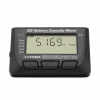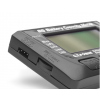G.T. Power Lipotester/Servotester
SKU: C91
Nicht im Lager
Verfügbarkeit überwachen
€ 20,79



Das Produkt kann nicht bestellt werden.
Multifunctional measuring device enabling battery condition testing, discharging and balancing Lithium batteries and testing servos and speed controllers.
Lithium battery testing
The device enables the measurement of 2-8S lithium batteries (Li-Po, Li-ion, LiFe, LiHV) without the need for additional power supply. To test 1S accumulators, you need to connect 4 NiXX battery or UBEC stabilizer output 5V to NiCd/MH socket. The battery under test is connected with a JST-XH balance connector.
The tester measures and displays:
- total battery voltage and residual battery capacity (state of charge - approximate data)
- voltage and residual capacity of individual cells of the set
- voltage and capacity of the cell of the set with the highest voltage
- voltage and capacity of the cell of the set with the lowest voltage
- cell numbers with the highest and lowest voltage and the voltage difference between them
Testing of NiCd and NiMH batteries
Testing 4-8S NiCd and NiMH batteries do not require an additional power source. For testing NiCd and NiMH batteries with less than 4 cells, a 2-8S lithium battery must be connected.
The tester measures and displays:
- total battery voltage
Discharger/Balancer
Lithium batteries can be discharged/balanced in two modes (the device is powered from a discharged battery):
- Discharge with balancing – the tester discharges the connected lithium battery to a pre-set voltage (2.0-4.2 V/cell) while equalizing the voltage of the individual cells
- Autonomous balancing - the device discharges the cells of the set to the level of the cell with the lowest voltage
Servo tester
The supply voltage for the servo tester function is 5-6 V (four-cell NiMH or NiCd battery or 5V UBEC output). In the case of testing ESCs with BEC, a separate power supply is not required. The servo tester generates control pulses with a logic "1" level of 4.7-5.0 V (depending on the supply voltage 5-6 V). Depending on the type of servo or ESC, you can choose the pulse frequency of the servo tester signal: 50Hz (for analog servos and regular ESCs for airplanes, cars and ships) and for digital servos and ESCs for multicopters 60 Hz, 100 Hz, 125 Hz, 200 Hz, 300 Hz .
The servo tester has three basic operating modes:
- Manual adjustment of the servo position with a rotary knob - the range of control pulse widths in this mode can be selected to the basic 1000-2000 µs or extended 500-2500 µs.
- Automatic servo overrun – in this mode, the servo automatically overruns within the set range (basic 1000-2000 µs or extended 500-2500 µs) at a manually adjustable speed.
- Neutral setting: – in this case, the servo tester provides a signal with a fixed pulse width of 1500 µs.
Hauptmerkmale
- Input Voltage: 2-8S LiXX, 4-8S NiXX (or 5V BEC)
- Discharge voltage: 2-4.2V per cell
- PWM pulse width for neutral: 1500uS
- PWM Range: Basic 1000-2000uS / Advanced 500-2500uS
- PWM frequency: 50/60/100/125/200/300Hz
- Size: 82x55x16mm
- Weight: 51g
Inhalt
- 1x Tester

